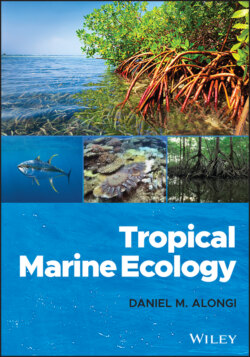Tropical Marine Ecology

Реклама. ООО «ЛитРес», ИНН: 7719571260.
Оглавление
Daniel M. Alongi. Tropical Marine Ecology
Table of Contents
List of Tables
List of Illustrations
Guide
Pages
Tropical Marine Ecology
Preface
CHAPTER 1 Introduction. 1.1 Definition of the Tropics
1.2 What Makes the Tropics Different?
References
CHAPTER 2 Weather and Climate. 2.1 Tropical Heat Engine
2.2 Tropical Winds and the Intertropical Convergence Zone (ITCZ)
2.3 Tropical Rainfall and Temperature Patterns
2.4 Monsoons
2.4.1 The Asian Monsoon
2.4.2 The Indo‐Australian Monsoon
2.4.3 The African Monsoons
2.4.4 The South American Monsoon
2.5 Tropical Weather Systems
2.6 The El Niño‐ Southern Oscillation (ENSO), the Indian Ocean Dipole (IOD), the Madden‐Julian Oscillation (MJO), and the Pacific Decadal Oscillation (PDO)
2.7 Climate Change: Physical Aspects
2.7.1 Rising Atmospheric CO2
2.7.2 Ocean Acidification
2.7.3 Rising Temperatures, Increased Storms, Extreme Weather Events, and Changes in Precipitation
2.7.4 Changes in Ocean Circulation
2.7.5 Sea‐Level Rise (SLR)
References
CHAPTER 3 Tropical Marine Hydrosphere. 3.1 Introduction
3.2 Large‐Scale Circulation Patterns
3.3 Coastal Circulation
3.4 Estuarine Circulation
3.5 Coral Reef Hydrodynamics
3.6 Fluid Mechanics in Seagrass Meadows
3.7 Tides
References
CHAPTER 4 Tropical Marine Geosphere
4.1 Major Sedimentary Patterns
4.2 Distribution of Major Habitat Types
4.3 Nutrients
4.4 Tropical River Loads, Plumes, and Shelf Margins
References
CHAPTER 5 Biogeography and Origins. 5.1 Tropical Biogeography
5.2 The Coral Triangle
5.3 Origins Explained
5.4 Marine Ecoregions and Provinces
5.5 The Latitudinal Diversity Gradient
References
CHAPTER 6 Populations and Communities. 6.1 Introduction
6.2 Density Independence, Density Dependence, and Intraspecific Competition
6.3 Populations with Age Structure
6.4 Meta‐populations
6.5 Interspecific Competition
6.6 Mutualism
6.7 Commensalism
6.8 Parasitism
6.9 Predation
6.10 Plant–Herbivore Interactions
6.11 Trophic Cascades
6.12 Facilitation Cascades
References
CHAPTER 7 Ecosystems. 7.1 Introduction
7.2 Rocky Shores
7.3 Sandy Beaches and Tidal Flats
7.4 Coastal Lagoons
7.5 Mangrove Forests
7.6 Seagrass Meadows
7.7 Coral Reefs
7.8 Continental Shelves
7.9 Open Ocean
References
CHAPTER 8 Primary Production. 8.1 Introduction
8.2 Sandy Beaches and Tidal Flats
8.3 Mangrove Forests
8.4 Seagrasses
8.5 Coral Reefs
8.6 Coastal Lagoons, Estuaries, and Tidal Waterways
8.7 Shelf Seas
8.8 Open Ocean
References
CHAPTER 9. Secondary Production. 9.1 Introduction
9.2 Heterotrophic Bacterioplankton
9.3 Zooplankton
9.4 Benthos
9.5 Fisheries
References
CHAPTER 10 Food Webs and Carbon Fluxes. 10.1 Introduction
10.2 Sandy Beaches and Tidal Flats
10.3 Rocky Intertidal Shores
10.4 Seagrass Meadows
10.5 Mangrove Forests
10.6 Coral Reefs
10.7 Estuaries and Coastal Lagoons. 10.7.1 Food Webs
10.7.2 Carbon Dynamics
10.8 Coastal Bays and Continental Shelves. 10.8.1 Trophic Dynamics
10.8.2 Carbon Cycling
10.9 Open Ocean
References
CHAPTER 11 Nutrient Biogeochemistry. 11.1 Introduction
11.2 Sandy Beaches, Tidal Flats, and Rocky Intertidal Shores
11.3 Seagrass Meadows
11.4 Mangrove Forests. 11.4.1 N Cycling
11.4.2 P Cycling
11.5 Coral Reefs
11.6 Estuaries and Coastal Lagoons
11.7 Coastal Bays and Continental Shelves
11.8 Open Ocean
References
CHAPTER 12 Pollution. 12.1 Introduction
12.2 Hydrocarbons
12.3 Metals
12.4 Eutrophication
12.5 Pesticides and Industrial Organic Chemicals
12.6 Plastics and Other Marine Debris
12.7 Biological Pollution. 12.7.1 Sewage and Microbial Diseases
12.7.2 Invasive Species
References
CHAPTER 13 Climate Change. 13.1 Introduction
13.2 Rising Temperatures, Increased Storms, Extreme Weather Events, and Changes in Precipitation
13.3 Sea‐level Rise (SLR)
13.4 Rising Atmospheric CO2
13.5 Ocean Acidification
13.6 Increasing Hypoxia
13.7 Impacts on Shelf and Oceanic Ecosystems and Fisheries
References
CHAPTER 14 Habitat Destruction and Degradation. 14.1 Introduction
14.2 Coral Reefs
14.3 Seagrass Meadows
14.4 Mangrove Forests
References
CHAPTER 15 Epilogue
Index. A
B
C
D
E
F
G
H
I
L
M
N
O
P
R
S
T
U
V
W
Y
Z
WILEY END USER LICENSE AGREEMENT
Отрывок из книги
DANIEL M. ALONGI
.....
I would like to acknowledge the staff of Wiley for doing such a wonderful, professional job in stitching this book together. I thank colleagues Bob Aller, Josie Aller, Michelle Burford, Erik Kristensen, Janice Lough, Matsui Mazda, Dave McKinnon, John (Charlie) Veron, Gullaya Wattayakorn, and Bob Wasson for critically commenting on various chapters. I am grateful to Morgan Pratchett and Ciemon Caballes for the photos of crown‐of‐thorns and coral bleaching. Finally, I thank my loving wife Fiona for her beautiful illustrations that have made this book much better than I had hoped and both my daughters for reminding me that there is indeed life after science. Of course, any errors are mine and I would be grateful for students, faculty, and other readers to bring any errors to my attention.
Daniel M. Alongi, PhD
.....